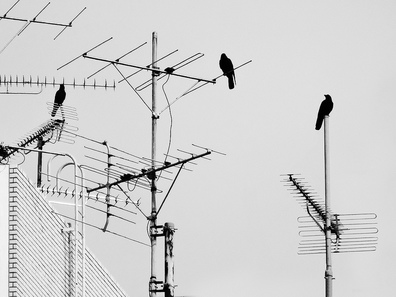Between Stockholm Syndrome and Lima Syndrome
Part 53: "Big Father is Watching Us"

Without buyers, there won't be sellers. Without demand, there won't be supply. Likewise, without believers, there won't be propagandists or, well, liars.
Propaganda, as discussed in Part 52 (The Power of Propaganda and Thanataphobia), should not be blamed only on its source. To a certain extent, its believers are also responsible because they willingly act as accessories to a crime: the crime of not thinking critically, the crime to let others "think" for themselves. In fact, we can use the dystopian novel Nineteen Eighty-Four (1984) published in 1949 by English novelist and social critic George Orwell (1903-1950) who warned us about the menaces of totalitarianism, as a cognitive prism.
Whereas the central theme of 1984 is that Big Brother is Watching You, in our current global religious landscape, Big Father is Watching Us. Political totalitarianism, as warned by Orwell, has transcended beyond Airstrip One in which we are all Winston Smiths. The very fact that most of us believe that "Big Father is Watching Us" makes us irresponsible and unaccountable creatures. Cause someone is going to redeem our sins anyway.
On the other hand, freedom from religion, as stated in Part 45 (The Law of Unintended Consequences in the Religious Industrial Complex), demands individual responsibility and accountability. Unfortunately, this sine qua non is a tall order for many. We can no longer comfortably hide behind Biblical or Koranic excuses, saviors, and redemption of any kind. The notions of heavenly rewards and hellish punishments (and twenty-one virgins waiting in paradise) go down the drain. In a religion-free environment, an individual is fully responsible and accountable for his or her own deeds.
Hence the cruel irony: agnostics and atheists tend to take religion much more seriously than theists. At the age of sixteen, British philosopher, logician and mathematician, Bertrand Russell (1872-1970) flatly declared: "(m)y whole religion is this: do every duty, and expect no reward for it, either here or hereafter." Observed another British, physician Jonathan Miller (b. 1934): "In some awful, strange, paradoxical way, atheists tend to take religion more seriously than the practitioners."
The similarities between political totalitarianism (as warned by Orwell) and religious totalitarianism (as we are witnessing today) are striking. Just take one of the slogans in "The Book" that "War Is Peace." Throughout the history of humankind, countless savage wars have been fought in the name of peace and merciful God and all kind of forgiving prophets. Another slogan—"Freedom is Slavery"—speaks volumes about the very core issue of how organized religions have enslaved believers instead of liberating them. But it is the third slogan—"Ignorance is Strength"—that has flawlessly exemplified the parallels between political and religious totalitarianism.
In Christian theology, for example, science and knowledge have had negative connotations. It is not an accident that the forbidden fruit of the Tree of Knowledge—not the Tree of Ignorance, mind you—was the cause of the original sin committed by Adam and Eve in the Fall of man as described in Genesis 2-3. Thus the primacy of ignorance over knowledge, and the rest is history.
The Catholic church burned Dominican friar, philosopher, mathematician and astrologer Giordano Bruno (1548-1600) at the stake as a heretic. He merely proposed that the stars were just distant suns surrounded by their own exo-planets in a center-less universe that is infinite, made from the same elements, and that matter was composed of intelligent atoms. Indeed the spectacular images sent by the Hubble Space Telescope of the Milky Way, other galaxies and even the most distant MACS0647-JD galaxy (13.3 billion light-years away) prove and confirm that Giordano Bruno was right! The fate of Galileo Galilei (1564-1642) would have been similar, if not for his personal friendship with Pope Urban VIII (1568-1644).
The strength of ignorance continues to this very day. In the states of Texas, Louisiana and Tennessee, laws to give teachers the freedom to question scientific theories including evolution were considered and applied. In the name of Islam, the Taliban and Boko Haram have openly declared war on education, kidnapped schoolgirls and terrorized students. In a video to claim credit for a wanton killing spree at a university in Pakistan, a Taliban commander made it clear: "We will continue to attack schools, colleges and universities across Pakistan as these are the foundations that produce apostates."
We are where we are, because we have been relentlessly bombarded by religious propaganda to worship the Tree of Ignorance instead of that of Knowledge.
[To be continued.]
Johannes Tan, Indonesian Translator & Conference Interpreter
Propaganda, as discussed in Part 52 (The Power of Propaganda and Thanataphobia), should not be blamed only on its source. To a certain extent, its believers are also responsible because they willingly act as accessories to a crime: the crime of not thinking critically, the crime to let others "think" for themselves. In fact, we can use the dystopian novel Nineteen Eighty-Four (1984) published in 1949 by English novelist and social critic George Orwell (1903-1950) who warned us about the menaces of totalitarianism, as a cognitive prism.
Whereas the central theme of 1984 is that Big Brother is Watching You, in our current global religious landscape, Big Father is Watching Us. Political totalitarianism, as warned by Orwell, has transcended beyond Airstrip One in which we are all Winston Smiths. The very fact that most of us believe that "Big Father is Watching Us" makes us irresponsible and unaccountable creatures. Cause someone is going to redeem our sins anyway.
On the other hand, freedom from religion, as stated in Part 45 (The Law of Unintended Consequences in the Religious Industrial Complex), demands individual responsibility and accountability. Unfortunately, this sine qua non is a tall order for many. We can no longer comfortably hide behind Biblical or Koranic excuses, saviors, and redemption of any kind. The notions of heavenly rewards and hellish punishments (and twenty-one virgins waiting in paradise) go down the drain. In a religion-free environment, an individual is fully responsible and accountable for his or her own deeds.
Hence the cruel irony: agnostics and atheists tend to take religion much more seriously than theists. At the age of sixteen, British philosopher, logician and mathematician, Bertrand Russell (1872-1970) flatly declared: "(m)y whole religion is this: do every duty, and expect no reward for it, either here or hereafter." Observed another British, physician Jonathan Miller (b. 1934): "In some awful, strange, paradoxical way, atheists tend to take religion more seriously than the practitioners."
The similarities between political totalitarianism (as warned by Orwell) and religious totalitarianism (as we are witnessing today) are striking. Just take one of the slogans in "The Book" that "War Is Peace." Throughout the history of humankind, countless savage wars have been fought in the name of peace and merciful God and all kind of forgiving prophets. Another slogan—"Freedom is Slavery"—speaks volumes about the very core issue of how organized religions have enslaved believers instead of liberating them. But it is the third slogan—"Ignorance is Strength"—that has flawlessly exemplified the parallels between political and religious totalitarianism.
In Christian theology, for example, science and knowledge have had negative connotations. It is not an accident that the forbidden fruit of the Tree of Knowledge—not the Tree of Ignorance, mind you—was the cause of the original sin committed by Adam and Eve in the Fall of man as described in Genesis 2-3. Thus the primacy of ignorance over knowledge, and the rest is history.
The Catholic church burned Dominican friar, philosopher, mathematician and astrologer Giordano Bruno (1548-1600) at the stake as a heretic. He merely proposed that the stars were just distant suns surrounded by their own exo-planets in a center-less universe that is infinite, made from the same elements, and that matter was composed of intelligent atoms. Indeed the spectacular images sent by the Hubble Space Telescope of the Milky Way, other galaxies and even the most distant MACS0647-JD galaxy (13.3 billion light-years away) prove and confirm that Giordano Bruno was right! The fate of Galileo Galilei (1564-1642) would have been similar, if not for his personal friendship with Pope Urban VIII (1568-1644).
The strength of ignorance continues to this very day. In the states of Texas, Louisiana and Tennessee, laws to give teachers the freedom to question scientific theories including evolution were considered and applied. In the name of Islam, the Taliban and Boko Haram have openly declared war on education, kidnapped schoolgirls and terrorized students. In a video to claim credit for a wanton killing spree at a university in Pakistan, a Taliban commander made it clear: "We will continue to attack schools, colleges and universities across Pakistan as these are the foundations that produce apostates."
We are where we are, because we have been relentlessly bombarded by religious propaganda to worship the Tree of Ignorance instead of that of Knowledge.
[To be continued.]
Johannes Tan, Indonesian Translator & Conference Interpreter





 RSS Feed
RSS Feed